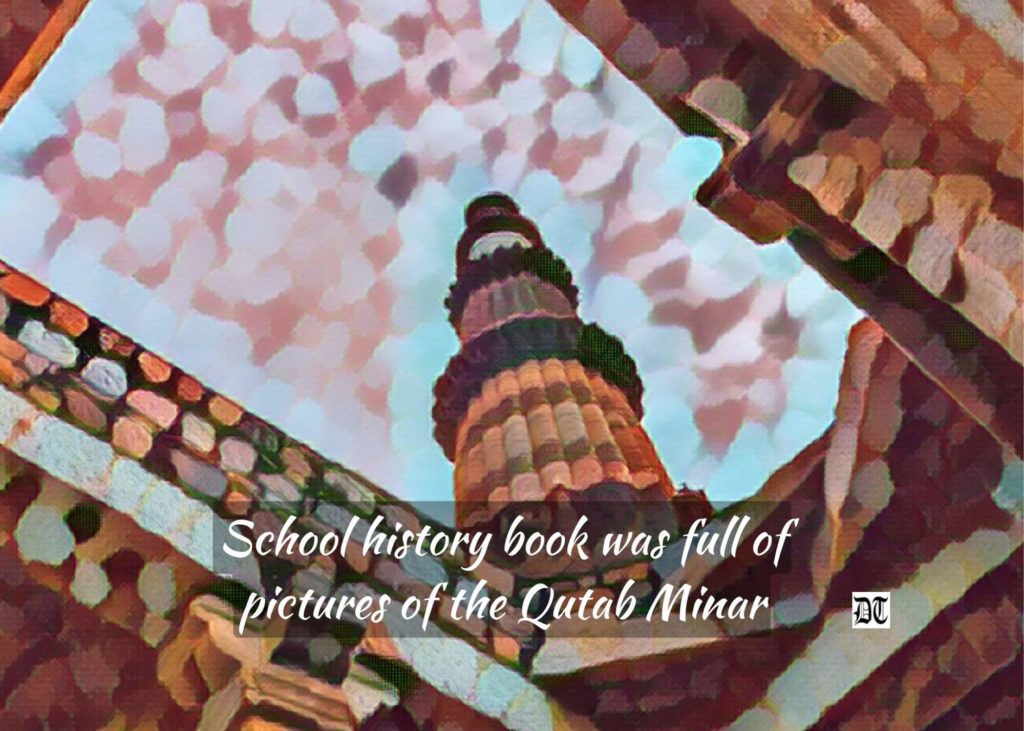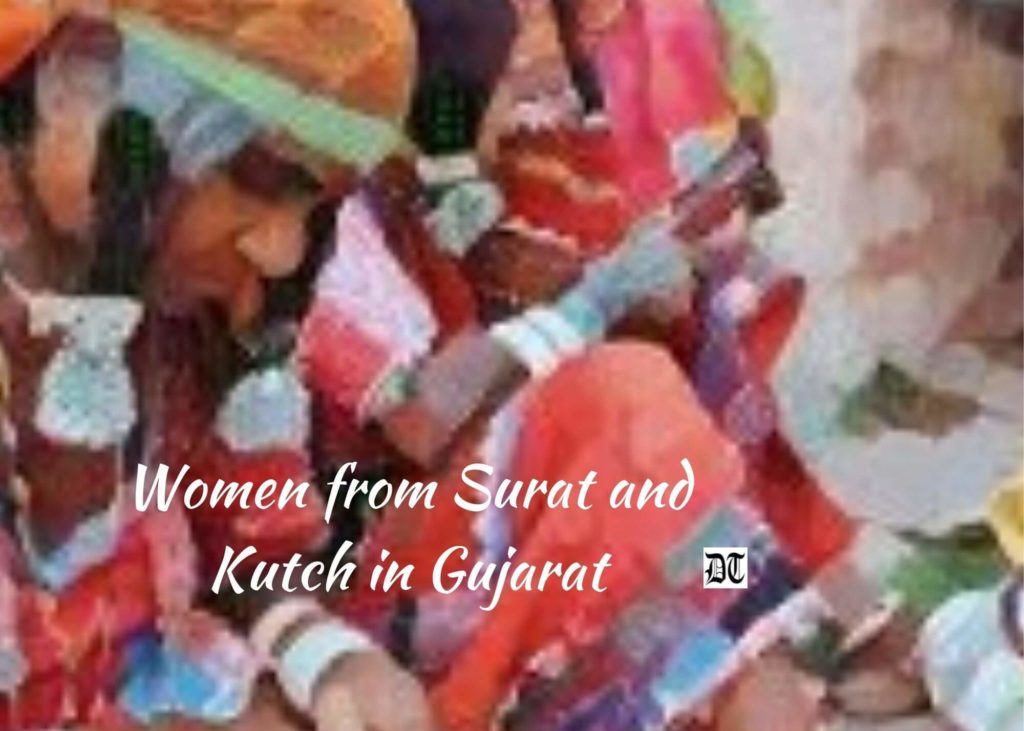Reading Time: 9 minutes
Dr. Roopali takes us on a tour of Delhi that she had known as a child to the megapolis that grew over time. A colour and mood story, exclusively for Different Truths.

Jhontoo, a cousin from small town Dhubri, on the banks of the river Brahmaputra, in India, visited us in Delhi. We happily took him to all the famed marketplaces – Pandara Road, Connaught Place, Lajpat Nagar, Sarojini Nagar, Karol Bagh, Chandni Chowk, and the elite Khan Market.
House guests gave us girls opportunities to freely roam around these marketplaces. A shopaholic aunt was so much more fun to bring along. We would just greedily look at all the dazzling clothes, trinkets, export rejects, secondhand fancy fur coats and jackets – the patri (pavement) bazaar attracting jostling crowds in the wintertime!
On these trips the otherwise miserly aunt would treat us to tongue tickling street food. Aloo tikki and chaat being the Delhi-ites’ favourite. Jaundice and cholera lurked sneakily.
Delhi, in the late 1970s, knew of only one shopping arcade, Yashwant Place.
Delhi, in the late 1970s, knew of only one shopping arcade, Yashwant Place. A stone’s throw away from our government-allotted house in the heart of the Diplomatic Enclave, Chanakyapuri. The diplomatic missions of many countries are lined up there, on either side of a boulevard called Shanti Path.
Yashwant Place was a huge building with labyrinthian corridors full of exotic shops. Next door was the fancy shell-shaped movie theatre called Chanakya Cinema.
Leather coats with fur collars, colourful handbags, shiny patent leather shoes, semi-precious stones, and large sized leather bags from Shantiniketan meant to stuff all our shopping in.
Loose leaf tea packed in hand carved wooden gift boxes flew off the shelves.
Loose leaf tea packed in hand carved wooden gift boxes flew off the shelves. The Babushka Grandma clientele from the Soviet Union crowded inside these shops. Occasionally, you’d spot a tall blonde mannequin-like figure. Lolling shopkeepers leered.
These were not connoisseurs. They were only couriers on a busy trade route. The cunning shopkeepers spoke a smattering of Russian, and haggled back – “Nyet, Tovarisch!” We were thoroughly impressed.
A day or two before Jhontoo was to return, his earlier goggle-eyed look had turned sad and droopy.
A day or two before Jhontoo was to return, his earlier goggle-eyed look had turned sad and droopy. At first when Mother enquired, he kept a surly silence. Her maternal persistence made him whimper, “I always dreamed of Delhi. My school history book was full of pictures of the Qutab Minar, the Red Fort, India Gate, Purana Quila and Birla Mandir. I am returning home without seeing anything. All day I sit in my father’s wholesale shop. I didn’t come here to see markets! My friends will laugh at me. What have I seen in Delhi? These two dragged me around markets and shops.”

We were shocked! How could somebody not like Delhi’s bazaars! “Idiot,” we muttered.
To avert a tragedy and a bad name he was quickly booked on a city tourist bus. Father dropped him off at the crack of dawn. Father’s Lambretta scooter putt-putted Jhontoo to Janpath from where he boarded the bus that would take him to the monuments.
Janpath, in New Delhi, was once called Queen’s Way. Kings Way was renamed Rajpath.
Janpath, in New Delhi, was once called Queen’s Way. Kings Way was renamed Rajpath. Decolonisation had begun soon after Independence. Janpath, which joins Connaught Place, has a row of shops once set up to relocate and rehabilitate Tibetan refugees. Crammed with real and fake artefacts, jewellery, statues of Buddha, Tara, Kali, big and small. All made of metal. White and oxidised metal. Apparently made to look antique. Of course, we found out these were actually made en masse in Chawri bazaar in Chandni Chowk.
There was and probably is usually a scruffy “hippy” couple or two in harem pants, Birkenstock sandals, and bandhini tie-dye dupatta scarves. They seem to love sifting through trays full of dragon or snake rings, dragon earrings, bracelets. The Tibetan shop owners are nowhere to be found anymore.
Women from Surat and Kutch in Gujarat, carrying a bundle of mirror worked textiles chase customers around.
Women from Surat and Kutch in Gujarat, carrying a bundle of mirror worked textiles chase customers around. They seem quite proficient in French and German! Now they have an alley of their own, where they can laugh and talk and deal with bargaining tourists and boutique memsahibs.
In the 1980s an underground market “rose up” in Delhi. The old outdoor Rambles Restaurant vanished. Its place was taken by Palika Bazaar. Subterranean splendour right in the centre of Connaught Place. And “fully air conditioned!” You name it and it was there. Electronics, cassette tapes, VCRs, cameras, ittar (scent) shops, ladies’ garments, cold coffee, pickles and murabba preserves of all kinds, silver jewellery, faux high-end fashion. Faceless fair complexioned mannequins sported colourful lingerie.

It was also a getaway from Delhi’s blistering summers.
It was also a getaway from Delhi’s blistering summers. Completely temperature-controlled, it was a unique shopping place. People roamed about unfettered – window shopping.
In the 1980s, a bomb blast by a group of insurgents diminished Palika Bazaar’s popularity. X-ray machines intrusive searching of one’s belongings became a deterrent. The armed guards sat around swatting flies. Dope peddlers began to turn up at sunset.
Over the years, we would unfailingly travel to Delhi annually. The parents needed to meet up with old friends or to watch a cricket match at the Feroze Shah Kotla grounds. Or just as a part of their perpetual graphic teaching programme for us. The India International exhibition at the Pragati Maidan expo grounds was another reason for the annual pilgrimage.
Birla Mandir and Kali Bari and the Buddha temple on Mandir Marg were very attractive places.
Birla Mandir and Kali Bari and the Buddha temple on Mandir Marg were very attractive places. Lots of space for kids to run about. Huge, sculpted elephants and caves with frightful faces and long slides offered endless fun. A playground and an amusement park of sorts with some deities to take care of you.
Not too far away Connaught Place with its gleaming white Greek pillars was a place of our dreams. We kids just loved outings to Connaught Place. The big red and blue king-sized helium filled “gas balloons” were a must! Russian story books being sold at pavement stalls were a delight. Ultra-cheap, and full of wondrous pictures of talking animals. Of singing ones too.
Tiny round kiosks sold packets of shiny new stamps with pictures of Sputnik and astronauts.
Tiny round kiosks sold packets of shiny new stamps with pictures of Sputnik and astronauts. Triangle shaped. Squares and rectangles. A philately hobbyist, the postage stamps we unglued from letters by soaking in a bowl of water looked like their poor cousins. An uncle informed us the shiny stamps were coded money to pay off Soviet spies. The Cold War was raging.
The singsong voice of the “Lakkar hajam pathar hajam” man drove us to giggle until our stomachs ached. His transparent small bottles filled with salty blackish powder promised to help digest stones and wood.
The shops had huge glass walls. You could peep into them. We’d spy Mother under heating head gear. Her permed head was getting its treatment inside the hair salon called AN John. One fine day she fulfilled her feminist dream. She bought a pressure cooker from a fancy crockery shop in Connaught Place. From that day she was liberated from the servitude of the kitchen. She could now cook a quick meal and watch a morning movie screening at Golcha Cinema, in Daryaganj, Old Delhi.
The Red Fort and Chandni Chowk area in Old Delhi is where the Mughals lived in splendour.
The Red Fort and Chandni Chowk area in Old Delhi is where the Mughals lived in splendour. Nowadays, you just crawl into a cycle rickshaw and take off through the cable hanging lanes and bylanes of Chandni Chowk. The Jama Masjid looming large in the background.
All that which lends glamour to our mundane life can be found here. Wedding ritual requirements, faux jewellery rentals, wedding decorations, Zari borders to enhance apparel, and wedding finery. The famed Meena Bazaar Silver Market of the Mughal times four hundred some years ago now boasts camera repair shops, electronic goods, and household items.
The rickshaw ride takes you past the Sees Ganj Gurudwara, the site of Sikh Guru Tegh Bahadur’s martyrdom…
The rickshaw ride takes you past the Sees Ganj Gurudwara, the site of Sikh Guru Tegh Bahadur’s martyrdom, in 1675; the 90-year-old Jain bird hospital, 19th century Urdu poet Mirza Galib’s haveli home, and the kotwali police station where a well-known figure of Sikh History, Bhai Mati Das was put to a gruesome death by Mughal Emperor Aurangzeb.
Your rickshaw will also take you on a meandering ride through the famed Gali Paranthe Waali. The densely populated street where the shops claim a 200-year-old heritage. They sell parantha (flat bread) with every possible stuffing. Manohar Dhaba has been in operation since 1949 and makes “Japani Samosa” without filling and only layers of wafer-thin pastry.
The ramparts of the Lal Qila (Red Fort) loom silent in grandeur.
The ramparts of the Lal Qila (Red Fort) loom silent in grandeur. The hustle and bustle honking of crowded buses, taxis, three-wheeler auto rickshaws, and cars do not seem to disturb its tranquil nature. It has been watching many centuries go by. A sentinel in red. A fort of fortitude. This is where independent India’s tricolour flag was first hoisted at midnight on August 15, 1947. When the world slept, We, the People of India, awoke to freedom.
There is shopping to be found inside the massive fort. But once you find yourself on the other side of the ramparts you behold the past majesty of Mughal emperors and empresses. The Deewan-e-khaas and the Deewan-e-aam. A pearl mosque, rows of fountains, rose gardens and a museum. The fort once overlooked the river Yamuna, which has since receded. The British Garrison buildings were later taken over by the Indian Army. They too have moved out.
The presence of these buildings inside peel off the pages of history.
The presence of these buildings inside peel off the pages of history. Barbarism was the order of the day. The civilised British occupiers beheaded the sons of a gentle Mughal Emperor Bahadur Shah Zafar. He was imprisoned and taken to Rangoon, where he died in exile, unsung and unhonoured. A beautifully curated son et lumière sound and light show tells us the story of those turbulent times.
In the name changing game Connaught Place morphed into Rajiv Chowk. They may again come up with a new name. Most times we forget the new name and only remember it as CP. Modern day evenings find Connaught Place to be a swarm of drug dealers and those looking to find a quick high. Phone and jewellery snatchers roam about freely.
We now take our Delhi visiting guests to Dilli Haat. A curated open-air art and culture enclave. India in a capsule.
The India Gate of my childhood years was the colourful lit up fountains and boat rides…
The India Gate of my childhood years was the colourful lit up fountains and boat rides, the bioscope man, and the ice cream cart. I carry memories of the grand statue of a King in flowing robes. He stood erect under a canopied stone pedestal opposite the India Gate. George the Vth Emperor of India majestically surveyed all that he believed belonged to him.
Then one day abracadabra disappeared. The canopy kept waiting for somebody else. Who that somebody should, would, or could be, led to quarrels followed by an ominous silence. Then, on another day, I found him. Decades later, in the company of an American traveller, our friend, Bob, a British Raj enthusiast.
King George V, Emperor of India, grandson of Queen Victoria and grandfather to Queen Elizabeth II, stood on a lofty pedestal with grand things written on it. His robes were amazingly carved, every fold looked and felt like velvet. I could touch it. The crown with its marbled jewels, the face full of self-created magnificence.
The Emperor of India now stood facing the bleak forgotten landscape of his grand Imperial Durbar court.
The Emperor of India now stood facing the bleak forgotten landscape of his grand Imperial Durbar court. He came, he saw, he just couldn’t conquer. Maharajas and Maharanis from all over India had set up home in Delhi in preparation to attend that Durbar. The courtiers long gone, he stood beside empty pedestals. A few had broken statues on them. Unidentifiable.
And below him lay a progeny of his former subject. Dreaming of good times, he lay on a string cot that had three legs, the fourth resting on a pile of bricks. Frayed shoes, a filthy pair of pajamas, a faded shirt … sir Ramulu, the municipal gardener.
“Hello-hello, wake up. We are free.” I shouted. He woke up startled and apologised. He was the watchman. His sleepless nights were thanks to a severed power connection and the swarms of mosquitoes. “Can you help me? Please ask the municipality to fix the power and give me a mosquito net.”
A watchman wanting to sleep. Who will guard the place?
A watchman wanting to sleep. Who will guard the place? What is there to guard?
The place reeked of irony. Shelley’s “Ozymandias” came to my mind:
I met a traveller from an antique land, Who said — “Two vast and trunkless legs of stone Stand in the desert …. Near them, on the sand, Half sunk a shattered visage lies, whose frown, And wrinkled lip, and sneer of cold command, Tell that its sculptor well those passions read Which yet survive, stamped on these lifeless things, The hand that mocked them, and the heart that fed; And on the pedestal, these words appear: My name is Ozymandias, King of Kings; Look on my Works, ye Mighty, and despair! Nothing beside remains. Round the decay Of that colossal Wreck, boundless and bare The lone and level sands stretch far away.”
Since January 26, 2022, the grand canopy has a new incumbent. India’s great patriot Netaji Subhash Chandra Bose.
Since January 26, 2022, the grand canopy has a new incumbent. India’s great patriot Netaji Subhash Chandra Bose. His military bearing, his clarion call, “Give me blood I will give you freedom,” his nationalism, and his struggle for his people have found a befitting time and the times have found a befitting icon.
The hologram image of Bose is drawing hundreds of visitors to India Gate. A fresh New Delhi is born.
Visuals by Different Truths














